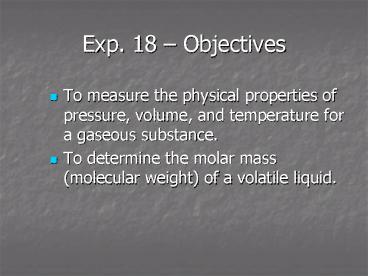Exp. 18 Objectives - PowerPoint PPT Presentation
1 / 7
Title:
Exp. 18 Objectives
Description:
To identify a newly synthesized compound, a chemist must determine its ... Large, non-volatile compounds such as biomolecules & pharmaceuticals. Old osmometer ... – PowerPoint PPT presentation
Number of Views:66
Avg rating:3.0/5.0
Title: Exp. 18 Objectives
1
Exp. 18 Objectives
- To measure the physical properties of pressure,
volume, and temperature for a gaseous substance.
- To determine the molar mass (molecular weight) of
a volatile liquid.
2
Exp. 18 Introduction
- To identify a newly synthesized compound, a
chemist must determine its physical properties - Melting point
- Color
- Density
- Boiling point
- Molar mass
3
Exp. 18 Introduction
- Measuring Molar Mass
- Large, non-volatile compounds such as
biomolecules pharmaceuticals - Old osmometer
- New mass spectrometer (m/z ratio)
- Volatile liquids
- Dumas method a known mass of the unknown liquid
is vaporized into a known volume at a measured
temperature and barometric pressure.
4
Exp. 18 Introduction
- Using the data and the ideal gas law equation,
the number of moles of the vaporized liquid are
determined - n PV/RT R 0.08206Latm/molK
- Once the number of moles (n) is known, the molar
mass is calculated by dividing the measured mass
(g) by n - molar mass mass(g)/n(moles)
5
Exp. 18 Introduction
- In the real world, few gases behave ideally.
- Gases with large intermolecular forces and large
molecular volumes do not behave according to the
ideal gas law equation. In this case, we use van
der Waals equation which is used to correct for
non-ideal behavior - (P n2a/V2)(V-nb) nRT
- a and b are called van der Waals Constants.
They are determined experimentally and can be
found in reference handbooks.
6
Exp. 18 Procedure Notes
- Part A Use a hot plate
- Part B.1 Adjust the water level high on the
Erlenmeyer flask. - Part B.2 Keep heating for 5 minutes after the
liquid appears to be gone. - Part B.4 Two trials, not three
- Part C.1 Check out a 150 or 200 mL graduated
cylinder from the stockroom.
7
Exp. 18 Report Sheet
- Questions 2, 4































